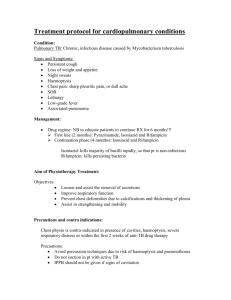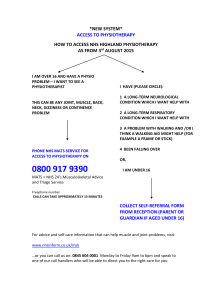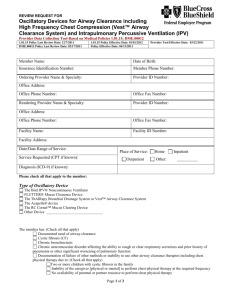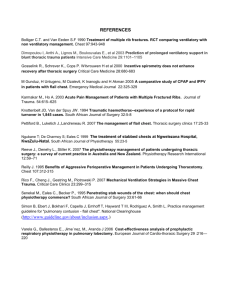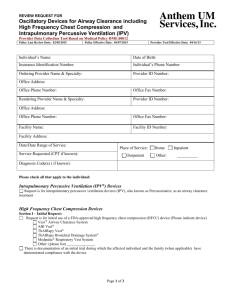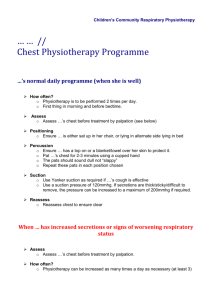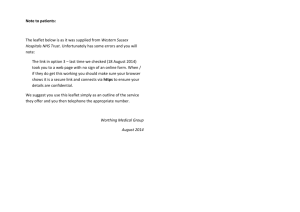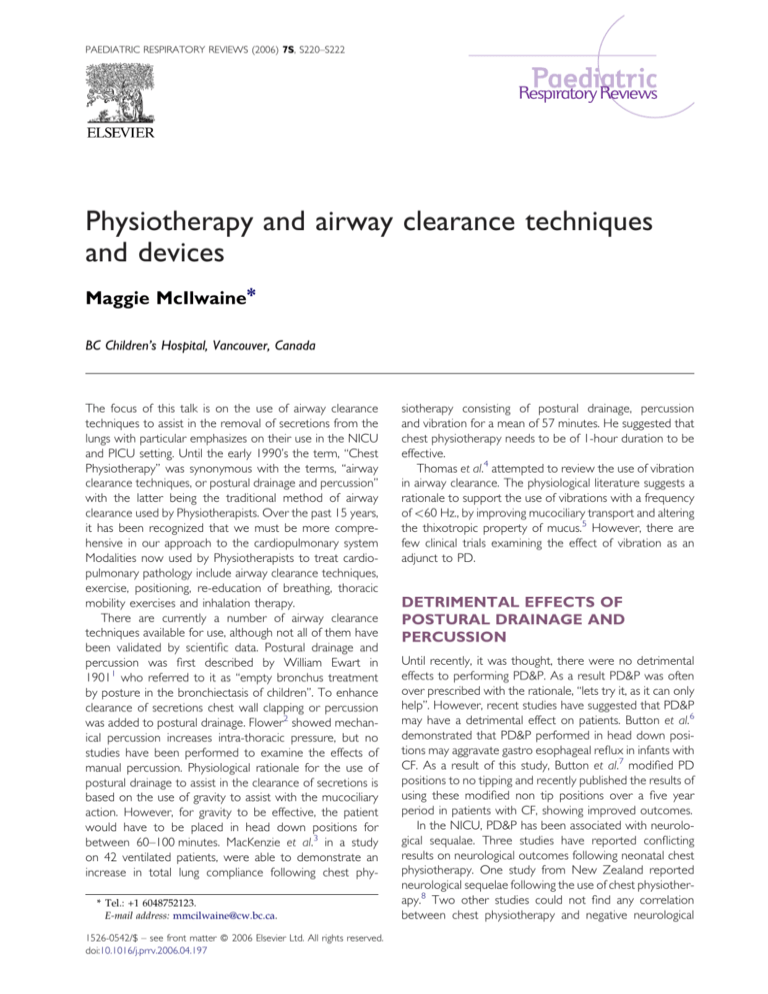
PAEDIATRIC RESPIRATORY REVIEWS (2006) 7S, S220–S222
Physiotherapy and airway clearance techniques
and devices
Maggie McIlwaine*
BC Children’s Hospital, Vancouver, Canada
The focus of this talk is on the use of airway clearance
techniques to assist in the removal of secretions from the
lungs with particular emphasizes on their use in the NICU
and PICU setting. Until the early 1990’s the term, ‘‘Chest
Physiotherapy’’ was synonymous with the terms, ‘‘airway
clearance techniques, or postural drainage and percussion’’
with the latter being the traditional method of airway
clearance used by Physiotherapists. Over the past 15 years,
it has been recognized that we must be more comprehensive in our approach to the cardiopulmonary system
Modalities now used by Physiotherapists to treat cardiopulmonary pathology include airway clearance techniques,
exercise, positioning, re-education of breathing, thoracic
mobility exercises and inhalation therapy.
There are currently a number of airway clearance
techniques available for use, although not all of them have
been validated by scientific data. Postural drainage and
percussion was first described by William Ewart in
19011 who referred to it as ‘‘empty bronchus treatment
by posture in the bronchiectasis of children’’. To enhance
clearance of secretions chest wall clapping or percussion
was added to postural drainage. Flower2 showed mechanical percussion increases intra-thoracic pressure, but no
studies have been performed to examine the effects of
manual percussion. Physiological rationale for the use of
postural drainage to assist in the clearance of secretions is
based on the use of gravity to assist with the mucociliary
action. However, for gravity to be effective, the patient
would have to be placed in head down positions for
between 60–100 minutes. MacKenzie et al.3 in a study
on 42 ventilated patients, were able to demonstrate an
increase in total lung compliance following chest phy* Tel.: +1 6048752123.
E-mail address: mmcilwaine@cw.bc.ca.
1526-0542/$ – see front matter ß 2006 Elsevier Ltd. All rights reserved.
doi:10.1016/j.prrv.2006.04.197
siotherapy consisting of postural drainage, percussion
and vibration for a mean of 57 minutes. He suggested that
chest physiotherapy needs to be of 1-hour duration to be
effective.
Thomas et al.4 attempted to review the use of vibration
in airway clearance. The physiological literature suggests a
rationale to support the use of vibrations with a frequency
of <60 Hz., by improving mucociliary transport and altering
the thixotropic property of mucus.5 However, there are
few clinical trials examining the effect of vibration as an
adjunct to PD.
DETRIMENTAL EFFECTS OF
POSTURAL DRAINAGE AND
PERCUSSION
Until recently, it was thought, there were no detrimental
effects to performing PD&P. As a result PD&P was often
over prescribed with the rationale, ‘‘lets try it, as it can only
help’’. However, recent studies have suggested that PD&P
may have a detrimental effect on patients. Button et al.6
demonstrated that PD&P performed in head down positions may aggravate gastro esophageal reflux in infants with
CF. As a result of this study, Button et al.7 modified PD
positions to no tipping and recently published the results of
using these modified non tip positions over a five year
period in patients with CF, showing improved outcomes.
In the NICU, PD&P has been associated with neurological sequalae. Three studies have reported conflicting
results on neurological outcomes following neonatal chest
physiotherapy. One study from New Zealand reported
neurological sequelae following the use of chest physiotherapy.8 Two other studies could not find any correlation
between chest physiotherapy and negative neurological
PHYSIOTHERAPY AND AIRWAY CLEARANCE TECHNIQUES AND DEVICES
S221
outcomes. In the New Zealand paper, vigorous percussion
was performed by nurses in the low birth weight infant
<1000 grams. In the other 2 papers only gentle physiotherapy using vibrations was performed in the LBW infant and
no neurological sequelae was reported.9,10
Rib fractures are another complication to be aware of in
the very young paediatric patient with the incidence being
reported as 1:1000 infants median age 3 months treated for
bronchiolitis and Pneumonia.11 Other adverse reactions to
PD&P include bronchospasm, changes in cardiac rhythm,12
and raised intracranial pressures in head-down positions.
Necessary oxygenation is required during chest physiotherapy and suctioning to prevent hypoxemia.
NEW EVIDENCE TO SUPPORT THE
USE OF PERCUSSION AND
VIBRATION IN NON-TIPPED
POSITIONS
VENTILATION
As a result of the research concerning the detrimental
effects of PD&P, the practice of Physiotherapy in relation to
PD&P in Canada has changed. No longer are head-down
positions used to assist in secretion removal, rather patients
are placed in positions to optimize ventilation to specific
lung regions. It has been speculated that the redistribution
of ventilation, as occurs with a change in body position,
might alter the local airway patency and gas/liquid
pump.13,14 Consequently, it can be hypothesized that
the physiological basis on which the concept of PD was
originally developed, may not be the only mechanism for
the improvement seen with changes in position as used in
PD positions. This hypothesizes is partly supported by
Lannefors and Wollmer15 who noted that more secretions
were cleared from the dependant lung rather than from the
uppermost lung during postural drainage.
AIRWAY CLEARANCE TECHNIQUES
IN NICU
For this Paper, eighteen studies were reviewed and summarized. Three systematic reviews could find no evidence
to support the routine use of prophylactic airway clearance
techniques for neonates. There was some evidence to
indicate the need for physiotherapy in neonates with
CXR changes and/or mucus plugging.16,10,17
There was substantial evidence to support the use of
physiotherapy to prevent post-extubation atelectasis and
reintubation18,19 however, physiotherapy needs to be given
2 hourly to obtain this effect. NIPPV and Nasal CPAP are
both effective evidence based treatments to facilitate weaning and extubation of preterm infants.20 As physiotherapy
may have deleterious consequences, it should only be
initiated by a physiotherapist after careful assessment and
an initial treatment to assess the effects of the treatment and
modifications necessary to accommodate the fragile state of
the patient. Only gentle physiotherapy with vibrations should
be performed in the low birth weight infant <1000 grams.
CURRENT AIRWAY CLEARANCE
TECHNIQUES
Over the past 20 years, other airway clearance techniques
have been developed which utilize ventilation to get the air
behind the secretions and then the expiratory airflow to
mobilize the secretions up the airways. These newer
techniques have been scientifically validated.21
Ventilation may be altered by a variety of methods. The
method chosen will depend upon the patient, lung pathology and the level of co-operation from the patient.
Simple positioning in side lying will alter ventilation to a
specific lung. Prone positioning will increase PaO2 by as
much as 10%, due to enhanced ventilation, although prone
positioning is not very practical in the PICU setting. Ventilation will be improved by an inspiratory vital capacity
maneuver with a three second breath hold. This maneuver
allows air to get behind secretions and avoids ventilator
asynchronism. It utilizes the principles of interdependence
and collateral ventilation.
Several airway clearance techniques incorporate these
breathing manoeuvres. The Active Cycle of Breathing(ACBT) utilizes both a deep inspiration with or without
a 3 second breath hold, while Autogenic drainage uses only
the 3 second breath hold. The three second breath hold is
very useful in post-operative patients or patients who have
restrictive lung disease.
Breath stacking performed with a one way valve and
Ambu mask is another method used to increase ventilation
and get air behind secretions in patients with restrictive lung
disease who are unable to take a full inspiratory effort
independently, i.e. neuromuscular patients and spinal cord
patients.
The Positive Expiratory Pressure Mask (PEP) increases
ventilation by applying a positive pressure of 10–20 cms H2O
at the mouth. FRC is increased during breathing through the
device and air moves behind secretions by use of collateral
ventilation. The Flutter and Acapella devices both utilize
positive expiratory pressure but the Flutter is based on
different physiological principles which decreases FRC during
use. This has been shown to have detrimental effects.22
High Frequency Chest Wall Oscillation (HFCWO) or
the ‘‘Vest’’ does not allow for increasing ventilation to a
particular lung region.
EXPIRATORY AIRFLOW
The use of the expiratory airflow to mobilize the secretions
up the airway has proven to be very effective. Lung
volumes, intra-bronchial pressures and pleural pressures
S222
are all adjusted to create optimum airflow to mobilize the
secretions.
Huffing uses a strong expiratory airflow which compresses the airways and squeezes the mucus up the airways.
It is based on the equal pressure point theory. ACBT and PEP
both use huffing to mobilize secretions up the airways. Care
needs to be taken to avoid too strong a compression leading
to bronchospasm. AD works well when hyperinflation is
present such as in Asthma, bronchiolitis, and cystic fibrosis. It
utilizes lower expiratory flow rates, avoiding airway compression, and exhaling into expiratory reserve volume. In
infants or when a patient is on a ventilator it can be
performed passively on the patient by the Physiotherapist.
Oscillating devices such as the Flutter and HFCWO
have a twofold effect on secretion clearance. Oscillation has
been shown to decrease the viscoelastic properties of
mucus hence making it easier to mobilize up the airways.
The second effect of the oscillations is to cause short bursts
of increased acceleration of the expiratory airflow which
assist in mobilizing the secretions up the airways.
In patients with a neuromuscular disorder or a spinal
cord injury, assisted coughing may be helpful to assisting in
mobilizing secretions up the airways.
UPPER AIRWAY SECRETION
CLEARANCE
When secretions are mobilized to the upper airways, a
strong cough will clear the secretions. If the patient is unable
to cough, suctioning may be required in the very ill patient.
In patients with a neuromuscular disorder or a spinal cord
injury, a coughalator is very effective in clearing secretions
from the larger airways.23
CONCLUSION
Physiotherapists now have a variety of airway clearance
techniques and devices available for use. Applying them to
the patient takes expertise not only in knowing the techniques but in understanding the physiology behind the
techniques and being able to adapt and apply the techniques to the individual patient. The Physiotherapist also
needs to know when airway clearance will be helpful to
the patient and when it will have no effect.
REFERENCES
1. Ewart W. Lancet 1901; 2: 70.
2. Flower KA, Eden RI, Lomax L, Mann NM, Burgess J. New mechanical
aid to physiotherapy in cystic fibrosis. BMJ 1979; 2: 630–631.
3. MacKenzie MB, Shin B, Hadi F, Imle PC. Changes in total lung/thorax
compliance following chest physiotherapy. Anaesthesia and Analgesia
1980; 59: 207–210.
M. McILWAINE
4. Thomas J, DeHueck A, Kleiner M, Newton J, Crowe J, Mahler S. To
vibrate or not to vibrate: Usefulness of the mechanical vibrator for
clearing bronchial secretions. Physiotherapy Canada 1995; 47: 120–
125.
5. King M, Phillips DM, Gross D. Enhanced tracheal mucus clearance with
high frequency chest wall compression. Am Rev Respir Dis 1983; 128:
511–515.
6. Button BM, Heine RG, Catto-Smith AG, Phelan PD, Olinsky A.
Postural drainage and gastro-oesophageal reflux in infants with cystic
fibrosis. Arch of Dis in Child 1997; 76: 148–150.
7. Button BM, Heine RG, Catto-Smith AG, Olinsky A, Phelan PD,
Ditchfield MR. Chest physiotherapy in infants with cystic fibrosis.
Pediatr Pulmonol 2003; 35: 208.
8. Harding JE, Miles FKI, Becroft DMO, Allen BC, Knight DB. Chest
physiotherapy may be associated with brain damage in extremely
premature infants. The Journal of Pediatrics 1998; 132: 440–444.
9. Beeby PJ, Henderson-Smart DJ, Lacey JL, Rieger I. Short- and longterm neurological outcomes following neonatal chest physiotherapy. J
Paediatr Child Health 1998; 34: 60–62.
10. Lacey JL. Chest physiotherapy. Department of Neonatal Protocol
Book 2000; Royal Prince Alfred Hospital.
11. Chalumeau M, Foix-L’Helias L, Scheinmann P, Zuani P. Rib fractures
after chest physiotherapy for bronchiolitis or pneumonia in infants.
Pediatric Radiology 2002; 32: 644–647.
12. Naylor JM, Chow CM, McLean AS. Cardiovascular responses to shortterm headdown positioning in healthy young and older adults. Physiotherapy Research International 2005; 10: 32–47.
13. Menkes H, Britt J. Rationale for physical therapy. Am Rev Respir Dis
1980; 122(suppl 2): 127–213.
14. Oberwaldner B. Physiotherapy for airway clearance in paediatrics. Eur
Respir J 2000; 15: 196–204.
15. Lannefors L, Wollmer P. Mucus clearance with three chest physiotherapy regimes in cystic fibrosis. A comparison between postural drainage, positive expiratory pressure and physical exercise. Eur Resp J
1992; 5: 748–753.
16. Flenady VJ, Gray PH. Chest Physiotherapy for preventing morbidity in
babies being extubated from mechanical ventilation. (Cochrane
Review). In: The Cochrane Library 2006; 1: Oxford Update Software.
17. Lewis JA, Lacey JL, Henderson-Smart DJ. A review of chest physiotherapy in neonatal intensive care units in Australia. J Paediatr Child
Health 1992; 28: 297.
18. Bloomfield FH, Teele RL, Voss M, Knight DB, Harding JE. The role of
neonatal chest physiotherapy in preventing postextubation atelectasis.
J Pediatr 1998; 133: 269–271.
19. Al-Alaiyan S, Dyer D, Khan B. Chest physiotherapy and post-extubation atelectasis in infants. Pediatr Pulmonol 1996; 21: 227–230.
20. Halliday H. What interventions facilitate weaning from the ventilator?
A review of the evidence from systematic reviews Paediatric Respir Rev
2004; 5(suppl A): S347–S352.
21. Langenderfer B. Alternatives to percussion and postural drainage. A
review of mucus clearance therapies: percussion and postural drainage, autogenic drainage, positive expiratory pressure, flutter valve,
intrapulmonary percussive ventilation and high frequency chest compression with the ThAIRapy vest. J Cardiac and Pul Rehab 1998; 18:
283–289.
22. McIlwaine PM, Wong LTK, Peacock D, Davidson AGF. A long-term
comparative trial of positive expiratory pressure(PEP) versus oscillating positive expiratory pressure(Flutter) in the treatment of cystic
fibrosis. J Pediatr 2001; 138: 845–850.
23. Winck JC, Goncalves M, Lourenco C. Effects of mechanical insufflationexsufflation on respiratory parameters for patients with chronic
airway secretion encumbrance. Chest 2004; 126: 774–780.

